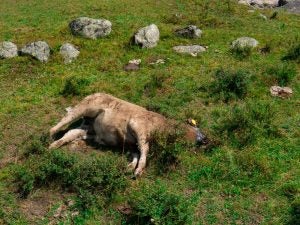The Minnesota Board of Animal Health confirmed the state’s first anthrax case in more than a decade, affecting animals in Kittson County. Multiple cattle and a horse are impacted, and officials have quarantined the property.
The board recommends producers keep their livestock up to date on anthrax vaccinations, especially in northwest Minnesota.
“One of the reasons we don’t see a lot of anthrax cases in the state anymore is because we have proactive measures to protect livestock like vaccinations,” said Dr. Katie Cornille, who oversees the Board’s bovine programs. “With this detection in Kittson County, livestock producers who graze their animals on pasture in and around the county should talk to their veterinarian about vaccinating their animals if they aren’t already.”
Anthrax is caused by a spore-forming bacterium called Bacillus anthracis, which can emerge in greater concentrations after rainstorms, flooding, or excavation. The disease has been concentrated in northwest Minnesota in the past.

»Related: Biosecurity in animal ag: Social distancing before it was cool
Anthrax in animals typically occurs in summer and affects livestock grazing on pasture, especially ruminants like cattle, sheep, and goats. Most animals die from the disease before showing any signs, so it’s essential to have a veterinarian examine animals that die suddenly or are found dead on pasture. If anthrax is suspected, veterinarians should avoid performing a field necropsy to prevent spore formation and contamination. Spores can survive in the soil for many years, endangering other animals.
Anthrax has occurred periodically in Minnesota livestock and was last confirmed in June 2013 in a Pennington County cow. All suspected anthrax cases in Minnesota animals must be reported to the Board of Animal Health immediately. Reporting cases to the Board ensures proper carcass disposal to prevent the spreading of the spores.
Anthrax in animals is not a risk to the public. The disease is spread through contact with affected animals or their products. Although the risk is low, people with contact with animals that have died of anthrax should consult their healthcare provider or the Minnesota Department of Health.
»Related: 10 weird livestock diseases, syndromes, and what to look for


